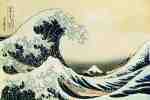Hokusai, full name Katsushika Hokusai (1760-1849), Japanese painter and wood engraver, born in Edo (now Tokyo). He is considered one of the outstanding figures of the Ukiyo-e, or "pictures of the floating world" (everyday life), school of printmaking.
Hokusai entered the studio of his countryman Katsukawa Shunsho in 1775 and there learned the new, popular technique of woodcut printmaking. Between 1796 and 1802 he produced a vast number of book illustrations and color prints, perhaps as many as 30,000, that drew their inspiration from the traditions, legends, and lives of the Japanese people. Hokusai's most typical wood-block prints, silkscreens, and landscape paintings were done between 1830 and 1840. The free curved lines characteristic of his style gradually developed into a series of spirals that imparted the utmost freedom and grace to his work, as in Raiden, the Spirit of Thunder.
In his late works Hokusai used large, broken strokes and a method of coloring that imparted a more somber mood to his work, as in his massive Group of Workmen Building a Boat. Among his best-known works are the 13-volume sketchbook Hokusai manga (begun 1814) and the series of block prints known as the Thirty-Six Views of Mount Fuji (circa 1826-33).
 The Great Wave Off Kanagawa
The Great Wave Off Kanagawa
Hokusai is generally more appreciated in the West than in Japan. His prints, as well as those by other Japanese printmakers, were imported to Paris in the mid-19th century. They were enthusiastically collected, especially by such impressionist artists as Claude Monet, Edgar Degas, and Henri Toulouse-Lautrec, whose work was profoundly influenced by them.
Photographs by Mark Harden and Carol Gerten-Jackson.